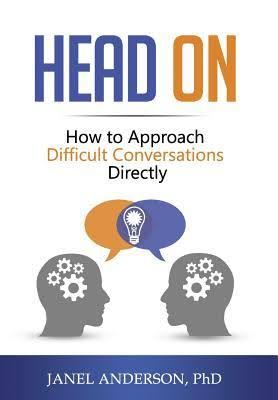
Head On: How to Approach Difficult Conversations Directly by Janel Anderson. Gale House: Farmington Hills, MI (2018). 230 + ix pages. US$15.95 (paperback).
As a young manager, I dreaded doing performance reviews. I never felt good about receiving performance feedback – even when it was stellar – from my managers in the past. I didn’t know how to conduct the performance review with my own staff and without all of us feeling bad.
What I desperately needed, as a new engineering manager, was a toolkit for communication, especially those very difficult conversations like performance reviews. Janel Anderson’s book, “Head On: How to Approach Difficult Conversations Directly,” offers methods for negotiating these difficult topics. Applying her techniques can improve both workplace and other relationships by increasing our ability to handle uncomfortable conversations.
“Head On” is divided into three sections. The first section summarizes neuroscience studies explaining why seemingly intelligent and competent people either become belligerent or shut down when faced with complex, emotionally-charged conversations. Part 2 provides tools, tips, and guidance for approaching sticky topics at home or at work. Finally, Part 3 gives the advice that I needed as a young engineering manager – how to handle performance reviews – along with other typical professional contexts where communication is challenged (meeting, senior management presentations, and so on).
Part 1: Neuroscience of Difficult Conversations
Dr. Anderson starts “Head On” with a quick review of the fight-or-flight mechanism. Though we are no longer trying to outrun lions in the jungle, our not-so-deeply buried animal instincts kick in whenever we feel threatened. “Our bodies do not distinguish between modern office politics and a saber-toothed tiger chasing us down” (pg. 11). So, we “fight” in difficult conversations by yelling or screaming, and we may literally take “flight” by leaving the room to avoid the discussion. Many people will take “flight” by simply disengaging from the situation but remaining physically present.
Anderson’s research into neuroscience also shows that human beings will assume a negative outcome when presented with an ambiguous situation. Of course, this is just the case when office rumors and gossip outweigh facts and authentic conversations.
The best tip from Part 1 of “Head On” is to become better in tune with your own physiological reactions to stress. Does your neck ache or your fists clench when the fight-or-flight mechanism is triggered? When you first recognize these symptoms, ground yourself by touching a familiar object (like your watch or eyeglasses) to validate that the conversation is challenging but also to reassure yourself that you can approach the topic calmly and logically.
Part 2: Step-by-Step Instructions
In Chapters 4 through 8, Anderson provides a manual to guide us through the difficult conversations. First, we need to prepare for the conversation. This means taking the time to understand the need to discuss the topic and clearing our emotions.
What does “clearing emotions” mean? We are often running from home to work and from meeting to meeting without taking a break. The stress from a situation earlier in the day can put us on edge and make a complicated situation worse because we let our emotions run together. Anderson advises taking a few moments before a tricky conversation to ground yourself (touch your watch or eyeglasses) and then clear your body of the past emotions.
From the neuroscience viewpoint, this is why you “take a deep breath” since these actions can literally clear toxic substances from the blood stream that build up stress. If possible, Anderson recommends a short walk or jog in a green space to effectively clear those negative emotions prior to a challenging discussion. Light physical activity helps prepare the body and mind for the next activity.
Next, the conversation must start with verifiable facts to keep your conversation partner from responding defensively and triggering his or her fight-or-flight mechanism. Practice active listening and acknowledging alternate perspectives. Then, you should close the conversation with agreement on action steps.
Here, Anderson describes two types of agreement. Type 1 agreement is resolved in a single conversation. Type 2 agreement, however, might require multiple discussions to achieve the desired behavior change with your team or staff member. In a Type 2 agreement, you close the conversation by describing your motivation and commitment to change the situation. Then, you ask for their commitment in return.
Part 3: Contextual Difficult Conversations
Finally, Chapter 11 in Part 3 addresses the specific situation of a performance review, often a very difficult conversation even when there is good news. Of course, performance feedback between a manager and direct reports should be ongoing and not reserved for an annual discussion. Feedback that is prompt can result in changed behaviors while delayed feedback more often yields a defensive response or disengagement with the task.
As I learned and as Anderson describes (pgs. 179-182), a manager must be able to read non-verbal cues that employees present during the review meeting. Often words don’t match the person’s posture which signals discord and lack of agreement with a go-forward plan. It’s okay to take a break during the discussion if you feel your emotional triggers (fight-or-flight) whether you are giving or receiving performance feedback.
Finally, Anderson closes “Head On” by acknowledging our human nature to make mistakes while we seek perfection. If we make an error, we can learn from it. Some difficult conversations start with “I’m sorry” and the parties build trust form there.
Handling Difficult Conversations
“Head On: How to Approach Difficult Conversations Directly” by Janel Anderson is an easy to read book with lots of tips and exercises to help us improve our workplace communications. Strongly grounded in neuroscience, the author provides many contextual examples of challenging discussions, providing guidance and step-by-step instructions to address specific conversation types. I recommend this book to anyone engaged in communication, but especially for engineering managers and team leaders responsible for employee development. Moreover, each of us can apply the actions and methods of “Head On” to improve our own abilities in conducting difficult conversations.
What triggers your fight-or-flight mechanism? How can you practice grounding yourself and clearing your emotions before a difficult conversation?
Teresa Jurgens-Kowal, PhD, PE, PMP, CPEM, NPDP
Global NP Solutions, LLC
